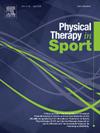Knee proprioception four months after anterior cruciate ligament reconstruction: Impact of limb dominance, anterolateral procedure, and association with readiness to return to sport
IF 2.2
3区 医学
Q1 REHABILITATION
引用次数: 0
Abstract
Background
Knee proprioception may be compromised after anterior cruciate ligament reconstruction (ACLR), but associated factors and impact remain unclear. This study evaluated knee proprioception 4 months after primary ACLR, compared with healthy controls, and explored the impacts of leg dominance, anterolateral procedures (AEAPs), and their association with psychological readiness to return to sports.
Methods
This prospective cohort study included 30 ACLR participants and 20 healthy controls. Isokinetic testing measured knee strength and proprioception, using passive joint position sense (JPS1: detection, JPS2: repositioning) and kinesthesia (threshold to detection of passive motion). At 8 months, ACLR participants completed the ACL-RSI scale to assess psychological readiness to return to sports.
Results
At 4 months postoperative, kinesthesia was better in the operated limb than the non-operated limb (p = 0.008), but position sense did not differ significantly. There were no significant differences in kinesthesia or position sense between ACLR participants and controls. The operated limb had worse JPS2 if the ACLR was on the non-dominant side. Proprioception was unaffected by AEAPs, and only repositioning showed a moderate, non-significant correlation with ACL-RSI (r = −0.377).
Conclusion
At 4 months post-ACLR, kinesthesia improved in the operated leg; dominance influenced position sense, highlighting the need for personalized rehabilitation.
前交叉韧带重建后4个月的膝关节本体感觉:肢体优势的影响,前外侧手术,以及与准备恢复运动的关系。
背景:前交叉韧带重建(ACLR)后,膝关节本体感觉可能受损,但相关因素和影响尚不清楚。本研究评估了原发性ACLR术后4个月的膝关节本体感觉,并与健康对照组进行了比较,探讨了腿优势、前外侧手术(AEAPs)的影响及其与重返运动心理准备的关系。方法:本前瞻性队列研究包括30名ACLR参与者和20名健康对照。等速测试使用被动关节位置感(JPS1:检测,JPS2:重新定位)和动觉(检测被动运动的阈值)测量膝关节力量和本体感觉。在8个月时,ACLR参与者完成了ACL-RSI量表,以评估重返运动的心理准备。结果:术后4个月,手术肢体的运动感觉优于非手术肢体(p = 0.008),但位置感觉差异无统计学意义。在ACLR参与者和对照组之间,运动感觉和位置感觉没有显著差异。如果ACLR位于非优势侧,则手术肢体的JPS2较差。本体感觉不受AEAPs的影响,只有重新定位与ACL-RSI有中度的、不显著的相关性(r = -0.377)。结论:aclr术后4个月,手术下肢运动感觉改善;优势影响位置感,突出个性化康复的需要。
本文章由计算机程序翻译,如有差异,请以英文原文为准。
求助全文
约1分钟内获得全文
求助全文
来源期刊

Physical Therapy in Sport
医学-康复医学
CiteScore
4.50
自引率
8.30%
发文量
125
审稿时长
39 days
期刊介绍:
Physical Therapy in Sport is an international peer-reviewed journal that provides a forum for the publication of research and clinical practice material relevant to the healthcare professions involved in sports and exercise medicine, and rehabilitation. The journal publishes material that is indispensable for day-to-day practice and continuing professional development. Physical Therapy in Sport covers topics dealing with the diagnosis, treatment, and prevention of injuries, as well as more general areas of sports and exercise medicine and related sports science.
The journal publishes original research, case studies, reviews, masterclasses, papers on clinical approaches, and book reviews, as well as occasional reports from conferences. Papers are double-blind peer-reviewed by our international advisory board and other international experts, and submissions from a broad range of disciplines are actively encouraged.
 求助内容:
求助内容: 应助结果提醒方式:
应助结果提醒方式:


